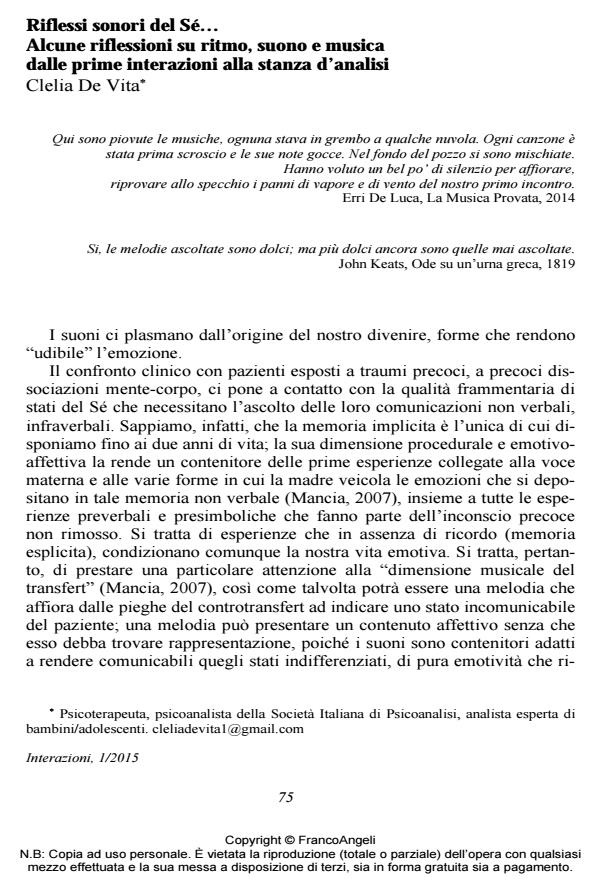Sound reflections of the Self. Considerations on rhythm, sound and music, from the first interactions to the consulting room,
Journal title INTERAZIONI
Author/s Clelia De Vita
Publishing Year 2015 Issue 2015/1
Language Italian Pages 17 P. 75-91 File size 71 KB
DOI 10.3280/INT2015-001007
DOI is like a bar code for intellectual property: to have more infomation
click here
Below, you can see the article first page
If you want to buy this article in PDF format, you can do it, following the instructions to buy download credits

FrancoAngeli is member of Publishers International Linking Association, Inc (PILA), a not-for-profit association which run the CrossRef service enabling links to and from online scholarly content.
The article offers some thoughts on the sound, rhythm and music as a means of communication that are of specific value in the development of the relationship between mother and child as well as in the relationship with patients early traumatized. The author connects the concept of transformational object (Bollas) to focus the value of the dynamic process of the relationship with the object whose sound exchanges represent an important moment, assuming that they can contribute to the construction of the child's inner world; the "maternal function of sound presentation" can contribute in a aesthetic way to formation of it. The sound can play a function of third in the relation between mother and child; it has a role in the experience of the baby's self-recognition in the mirror at the "mirror stage", because the sound of maternal voice helps to give a three-dimensional quality to the recognition of child’s image. Some clinical examples provide stimulus for reflection to the role of non-verbal communication and sound memories during analytic sessions, which gives a unique and powerful way to contact otherwise inexpressible experiences.
Keywords: Sound, tuning, transformative object, preverbal, sound mirroring, sound presentation function
- Anzieu D. (1987). L’Io pelle. Roma: Borla.
- Ardizzone I., De Vita C. (2000). La colonna sonora della relazione madrebambino. Relazione letta preso il Dipartimento di Neuropsichiatria Infantile dell’Università di Roma La Sapienza.
- Bollas C. (1989). L’ombra dell’Oggetto. Roma: Borla.
- Bollas C. (2009). Il mondo dell’oggetto evocativo. Roma: Astrolabio.
- Bromberg P.M. (2007). Clinica del trauma e della dissociazione. Milano: Cortina.
- Cates Lorrane B. (2014). Insidious Emotional Trauma: the Body Remembers. International Journal of Psychoanalytic Self Psychology, 9: 35-53. DOI: 10.1080/15551024.2014.857751
- De Luca Erri (2014). La musica provata, Milano: Einaudi.
- De Toffoli C. (2014). Transiti Corpo-Mente. Milano: Franco Angeli.
- Grotstein J.S. (2010). Un raggio di intensa oscurità. Milano: Cortina.
- Kohut H. (1957). Observation on the Psychological function of music. Journal Amer. Psychoanal. Assn., 5: 389-407.
- Lacan J. (1948). Lo stadio dello specchio come formatore della funzione dell’io. In: Lacan J., Scritti. Torino: Einaudi.
- Lackman F.M. (2001). Chapter 14 Words and Music. Progress in Self Psychology, 17: 167-178.
- Langer S. (1948). Philosophy in a New Key. New York: New American Library.
- Mancia M. (2007). La psicoanalisi in dialogo con le neuroscienze: lo stato dell’arte. Rivista di Psicoanalisi, LII, 4: 1015-1032.
- Meltzer M, Harris M. (1989). Amore e Timore della bellezza. Quaderni di Psicoterapia Infantile, 20. Roma: Borla.
- Rilke R. M. (1923). Elegie Duinesi. Torino: Einaudi.
- Sacks O. (2007). Musicofilia. Milano: Adelphi. Stern D. (1985). Il mondo interpersonale del bambino. Torino: Boringhieri.
- Vermote R. (2015). Relazione al Convegno Essere/Divenire. L’esperienza della Psicoanalisi, Centro di Psicoanalisi Romano Roma, 31 Gennaio 2015.
- Winnicott D. (1970). Sviluppo affettivo e ambiente. Roma: Armando.
- Zuckerkandl V. (1956). Sound and Symbol: Music and External World. New Jersey: Princeton University Press.
- Estranea o straniera? Lingua e filiazione nella migrazione Clelia De Vita, in INTERAZIONI 1/2021 pp.112
DOI: 10.3280/INT2021-001009
Clelia De Vita, Riflessi sonori del Sé.. Alcune riflessioni su ritmo, suono e musica dalle prime interazioni alla stanza d’analisi in "INTERAZIONI" 1/2015, pp 75-91, DOI: 10.3280/INT2015-001007